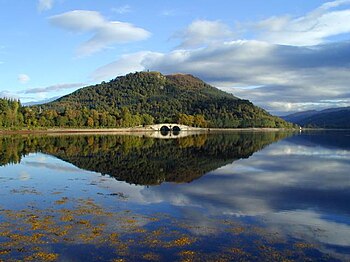Loch Fyne

Loch Fyne is a sea loch on the west coast of Argyllshire. The county town, Inveraray, stands on its shores, the fairy-tale Inveraray Castle overlooking its waters. The loch extends 40 miles inland from the Sound of Bute, making it the longest of the sea lochs. It is connected to the Sound of Jura by the Crinan Canal.
Its name is from the Gaelic Loch Fìne, which means 'Loch of the Vine (or Wine)', though there is no evidence that grapes have grown there.
Loch Fyne has a reputation for its oyster fishery, and as a consequence the loch has given its name to the locally-owned Loch Fyne Oysters and to the associated Loch Fyne Restaurants. It is also notable for its herring-fishing industry, and hence the famous Loch Fyne Kipper, originally caught using the drift-net method. In the mid-19th century, Loch Fyne was the centre of the battle in 1833 between the traditional drift-net fishermen and the new trawl-net fishermen who sprang up around Tarbert and Campbeltown at that time.[1]
Loch Fyne is a popular area for sport diving and fishing. It is also a popular tourist destination with attractions such as Inveraray Castle and the nearby ruins of Castle MacEwen and Old Lachlan Castle.
Several sea-fishing records have been set in the Loch:
| Species | Weight | Angler / Date |
|---|---|---|
| Dogfish Black Mouthed | 02-13-08 | J. H. Anderson, 1977 (Boat) |
| Poor Cod | 01-00-00 | F. Johnstone, 1970 (Shore) |
| Tadpole Fish | 01-04-00 | H. Donnelly, 1995 (Shore) |
| Blue Whiting | 01-12-00 | J. H. Anderson, 1977 (Boat) |
The village of Portavadie is on the east shore of the loch. A passenger ferry traverses the loch to Tarbert from the slipway at Portavadie.
Dolphins, seals and otters inhabit the loch, and basking sharks can appear in its waters during the summer months. A Ross's Gull was present at the loch in early 2007.
In the north the terrain is mountainous, with the Arrochar Alps, Beinn Bhuidhe, Glen Shira, Glen Fyne, Glen Croe, Arrochar, Tyndrum and Loch Lomond nearby.
Around a quarter of a million soldiers trained at HMS Quebec, No.1 Combined Training Centre, Inveraray in amphibious-landing techniques on the shores of Loch Fyne before the D-day landings.
Pictures
-
Inverary harbour
-
Towards the north-eastern tip of the loch
-
The view down the loch from Inveraray
References
- ↑ The Rinn-Net Fishermen, Martin


